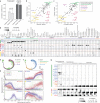An organism-wide atlas of hormonal signaling based on the mouse lemur single-cell transcriptome
- PMID: 38467625
- PMCID: PMC10928088
- DOI: 10.1038/s41467-024-46070-9
An organism-wide atlas of hormonal signaling based on the mouse lemur single-cell transcriptome
Abstract
Hormones mediate long-range cell communication and play vital roles in physiology, metabolism, and health. Traditionally, endocrinologists have focused on one hormone or organ system at a time. Yet, hormone signaling by its very nature connects cells of different organs and involves crosstalk of different hormones. Here, we leverage the organism-wide single cell transcriptional atlas of a non-human primate, the mouse lemur (Microcebus murinus), to systematically map source and target cells for 84 classes of hormones. This work uncovers previously-uncharacterized sites of hormone regulation, and shows that the hormonal signaling network is densely connected, decentralized, and rich in feedback loops. Evolutionary comparisons of hormonal genes and their expression patterns show that mouse lemur better models human hormonal signaling than mouse, at both the genomic and transcriptomic levels, and reveal primate-specific rewiring of hormone-producing/target cells. This work complements the scale and resolution of classical endocrine studies and sheds light on primate hormone regulation.
© 2024. The Author(s).
Conflict of interest statement
The authors declare no competing interests.
Figures








References
-
- Takei, Y., Ando, H. & Tsutsui, K. Handbook of Hormones: Comparative Endocrinology for Basic and Clinical Research (Academic Press, 2015).
MeSH terms
Substances
Grants and funding
LinkOut - more resources
Full Text Sources

